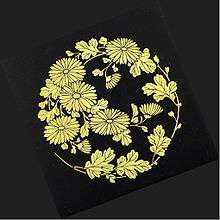Maki-e


Maki-e (蒔絵, literally: sprinkled picture) is Japanese lacquer sprinkled with gold or silver powder as a decoration using a makizutsu or a kebo brush. The technique was developed mainly in the Heian period (794–1185) and blossomed in the Edo period (1603–1868). Maki-e objects were initially designed as household items for court nobles; they soon gained more popularity and were adopted by royal families and military leaders as a symbol of power.
To create different colours and textures, maki-e artists use a variety of metal powders including gold, silver, copper, brass, lead, aluminum, platinum, and pewter, as well as their alloys. Bamboo tubes and soft brushes of various sizes are used for laying powders and drawing fine lines. As it requires highly skilled craftsmanship to produce a maki-e painting, young artists usually go through many years of training to develop the skills and to ultimately become maki-e masters. Kōami Dōchō (1410–1478) was the first lacquer master linked to specific works. His maki-e works used designs from various Japanese contemporary painters. Kōami and another maki-e master, Igarashi Shinsai, were originators of the two major schools of lacquer-making in the history of Japan.
Takamakie (or "raised maki-e") is one of the three major techniques in maki-e making. Developed in the Muromachi period (1336–1573), the technique of takamakie involves building up design patterns above the surface through a mixture of metal powder, lacquer, and charcoal or clay dust.
Another special kind of maki-e is togidashi maki-e, where a black lacquer without oil is put on the metal decoration as an additional coat.
References
- Lacquerware stories/maki-e
External links
-
 Media related to Maki-e at Wikimedia Commons
Media related to Maki-e at Wikimedia Commons - Maki-e at Britannica